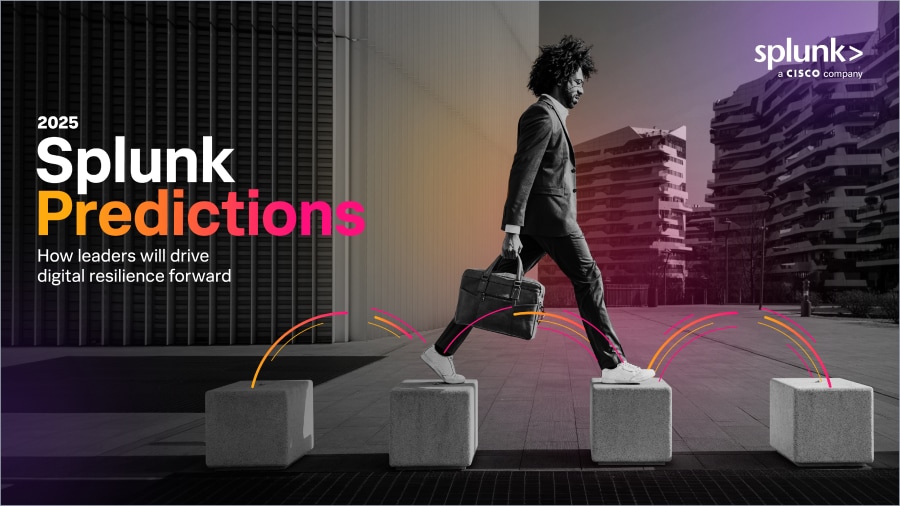APAC in 2025: A Harder Look at AI, Data and Cybersecurity Standards

This year has been transformative for technology, reshaping the business landscape with groundbreaking advancements and unprecedented challenges. Generative AI continues to unlock new possibilities, while cybersecurity threats have escalated to new heights. Across APAC — a fast-emerging global innovation hub — businesses have grappled with the twin forces of regulatory evolution and technological breakthroughs.
As we enter 2025, the pace of change shows no signs of slowing. For business leaders, success will depend on navigating these disruptions strategically and seizing the opportunities they present. With the launch of our Splunk Predictions 2025 report, we continue to outline the next steps for the AI era — and three key trends that will be pertinent to the APAC region in the year ahead.
Trend 1: A Material Shift for Cybersecurity in APAC
The rise in data breaches and critical infrastructure attacks has made cybersecurity a top priority across APAC. In Singapore alone, there were 201 government data incidents reported in 2023 — a 10% increase from the previous year. In response, we see governments moving to define "cybersecurity materiality," setting clearer expectations for organisations to manage cyber risks more effectively.
For instance, Australia is introducing its first standalone cybersecurity legislation as part of its 2023-2030 Cyber Security Strategy. This law mandates that businesses report ransomware payments to the authorities within 72 hours, with failure to comply resulting in a hefty fine. These regulations mark a turning point, setting new expectations for how organisations must manage cyber risks.
Materiality in cybersecurity is currently subjective, leaving gaps in accountability and exposing businesses to penalties and reputational damage. As cybercriminals increasingly use AI to launch sophisticated attacks on critical infrastructure and supply chains, a clear, unified definition of materiality is urgently needed. Such standards will drive organisations to adopt advanced practices — such as integrating AI in Security Operations Centres (SOCs) to detect, understand, and respond to threats more effectively.
Unified standards will not only improve incident responses but also build trust, enhance resilience, and foster long-term success in a hyper-connected digital economy.
Trend 2: AI Must Adapt to Prove Itself
 The era of blank checks for AI is over — as initial excitement fades, businesses are focused on evaluating AI’s actual value. Some AI pilots have fallen short of expectations, prompting a pivot in 2025 toward targeted investments that address regional priorities like cybersecurity, workforce productivity, and customer experience. Executives will prioritise AI initiatives with clear ROI, funding only those that deliver tangible, demonstrable results.
The era of blank checks for AI is over — as initial excitement fades, businesses are focused on evaluating AI’s actual value. Some AI pilots have fallen short of expectations, prompting a pivot in 2025 toward targeted investments that address regional priorities like cybersecurity, workforce productivity, and customer experience. Executives will prioritise AI initiatives with clear ROI, funding only those that deliver tangible, demonstrable results.
As a result, we are likely to see domain-specific small language models (SLMs) increasingly replace general-purpose large language models (LLMs), offering greater accuracy, efficiency, and sustainability. Especially in APAC, where the growing strain of data-intensive AI workloads is placing pressure on regional power grids and driving up operational costs for data centres. IDC report shows that AI data centre energy consumption in the region is projected to reach 146.2 terawatt-hours by 2027 — thus, a shift toward smaller, more efficient models can significantly reduce the energy and computational demands of AI systems.
That said, despite the higher upfront costs, LLMs remain crucial for more complex, multi-purpose tasks where scalability and performance are essential. In 2025, businesses will need to carefully balance the mix of both language models in their AI strategies. As AI adoption continues to grow, it will play a critical role in addressing workforce gaps, enhancing digital observability, and driving meaningful improvements in customer experiences.
Trend 3: Resilience Begins with Observability
Monitoring today’s complex application architectures is becoming increasingly challenging, with APAC reporting a staggering loss of US$187M annually due to downtime. The region also recorded the longest recovery times compared to other regions. Beyond these direct financial losses, poor digital experiences undermine customer loyalty and harm reputations.
This is where observability could bridge the gap between system performance and business outcomes — by connecting metrics like customer conversion and revenue to operational efficiency. By shifting from reactive troubleshooting to proactive optimisation, observability enables organisations to identify and address performance issues before they impact end users.
AI is transforming this process.
By correlating and summarising vast amounts of data, AI makes it easier for organisations to uncover insights and make data-driven decisions. With AI-driven observability, businesses can prioritise issues, align teams, and ensure a seamless end-user experience — all while demonstrating the ROI of their efforts.
Data at the Heart of Resilience and Innovation
Security, innovation, and AI all revolve around one critical factor: data. Modern security threats exploit weaknesses in data management — such as poor encryption, inadequate access controls, and weak governance — leading to risks like data breaches and ransomware attacks. Meanwhile, observability data, including logs, metrics, and traces, provides insights for proactively addressing issues and driving innovation. Similarly, AI’s success relies on clean, accurate, and unbiased data; poor-quality training data can lead to biased models and inaccurate predictions, undermining trust and outcomes.
As we move into 2025, data remains the foundation of success. Global data creation is projected to exceed 394 zettabytes in the next five years, yet many organisations struggle to harness its full potential.
For APAC businesses, the path forward lies in moving beyond traditional storage and archiving to adopt federated data management strategies that enable real-time insights and smarter decision-making. Operational data — such as telemetry and quality-of-service metrics — plays a vital role in boosting employee productivity and enhancing customer satisfaction, making it a critical driver of innovation and resilience.
From cybersecurity to AI advancements, the rose tinted glass has come off for APAC in 2025 — organisations must be ready to face rising expectations and be able to answer questions around value and ROI in an increasingly unforgiving business landscape. Success will come to those who act now: strengthening their foundations, staying agile to adapt to rapid change, and using data to drive smarter, faster decisions.
Related Articles
About Splunk
The world’s leading organizations rely on Splunk, a Cisco company, to continuously strengthen digital resilience with our unified security and observability platform, powered by industry-leading AI.
Our customers trust Splunk’s award-winning security and observability solutions to secure and improve the reliability of their complex digital environments, at any scale.




